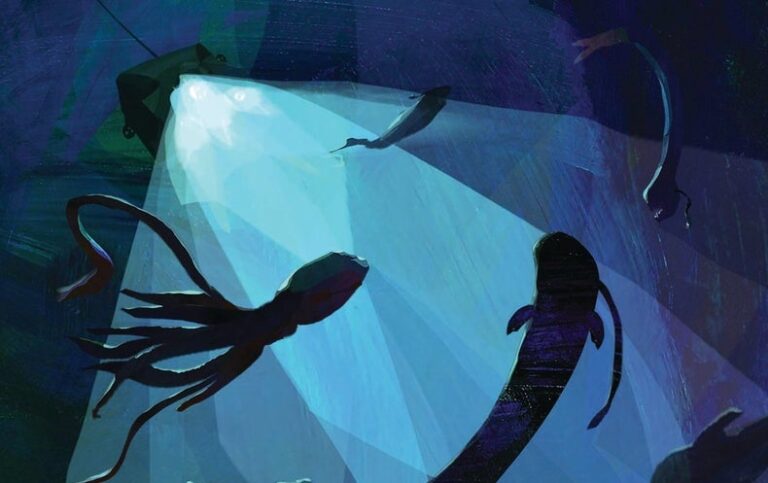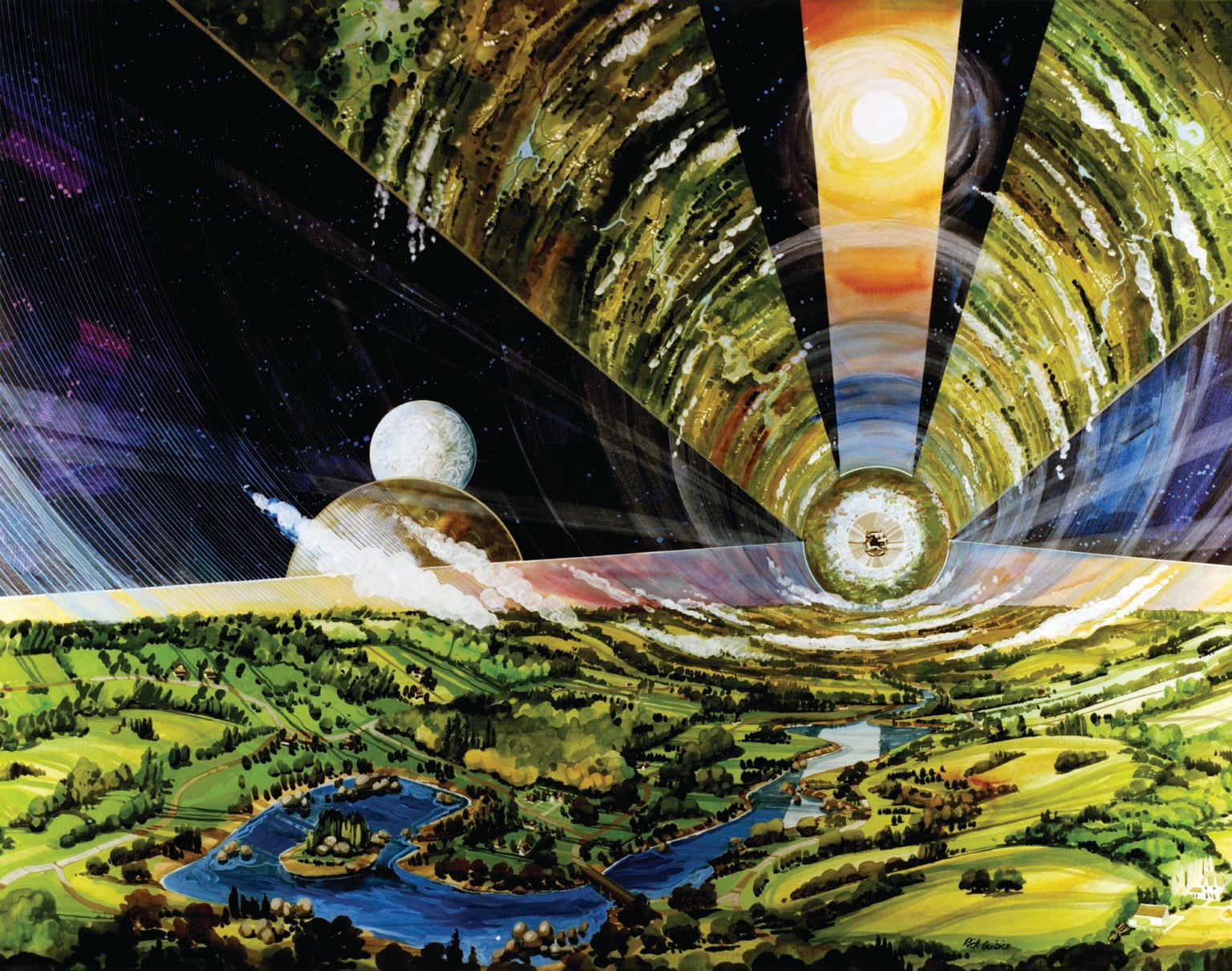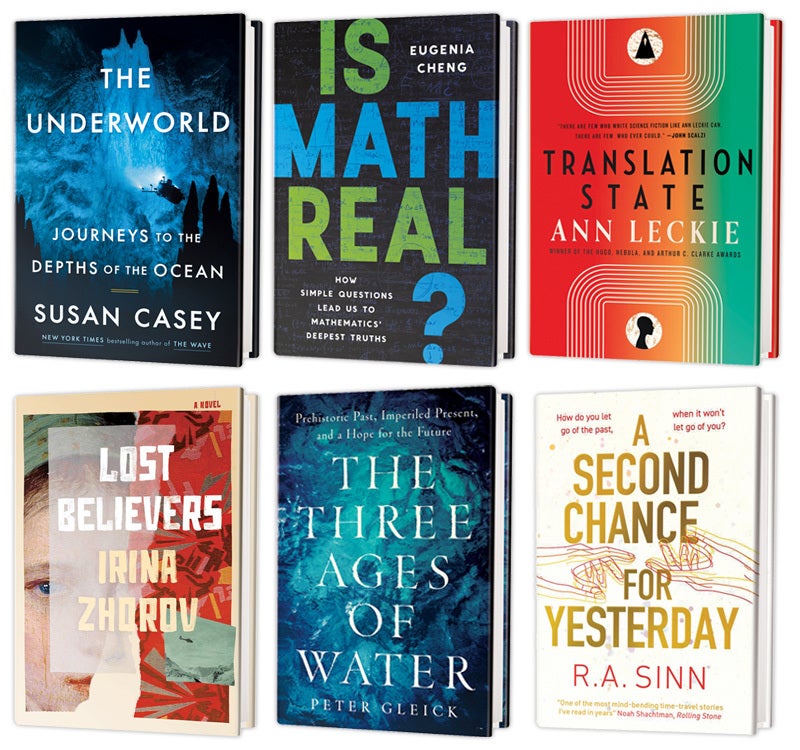
[ad_1]
Nonfiction
Exploring, and Exploiting, the Ocean’s Depths
A new history of the deep sea—and the forces that threaten it
The Underworld: Journeys to the Depths of the Ocean
by Susan Casey
Doubleday, 2023 ($32)
The first bathysphere made its initial descent off an island in Bermuda on June 6, 1930, lowered into the Atlantic Ocean by a shipboard winch. The vessel was a crude metal sphere pocked with tiny quartz windows, akin to finger holes in a bowling ball. The plunge was terrifying: leaks could spring, air could dwindle, portholes could collapse. A broken cable would send the bathysphere plummeting into oblivion.
Yet the people inside it—naturalist William Beebe and engineer Otis Barton—were as enchanted as they were frightened. The vividness of the blue light transcended language: “more like an emotion than a color,” writes Susan Casey in The Underworld, her entertaining account of the technologies and scientists who have shaped deep-sea exploration. The deep was a realm both inhospitable and lively, a place where fear and awe coexisted— “an ungovernable territory,” as Casey puts it, “that begins where the sunlight stops.”
Nearly a century after the bathysphere’s voyage, it’s often said that we know more about deep space than about the depths of our own planet. We’ve named practically every large moon crater yet thoroughly charted just 25 percent of the seafloor. The ocean isn’t less accessible than space; we simply haven’t prioritized it. For every dollar the federal government shells out on ocean exploration, it gives hundreds to NASA. The U.S. Navy has 11 aircraft carriers but not one submersible capable of accessing the ocean’s deepest spots.
Casey posits that the roots of humanity’s aversion run, well, deep. Venturing into space offers “the illusion of expansion” into a limitless cosmos, whereas our ocean sloshes across a planet we feel we’ve already conquered. It’s also just plain creepy. The deep sea is Earth’s “haunted basement—sinister, shrouded in blackness, spewing molten rock and poisonous gases, a den of freaky beings and hoary specters.”
Happily, not everyone harbors such antibenthic prejudice. This is Casey’s fourth marine-themed book. In The Wave (2010), she chases gargantuan swells that swallow ships and enrapture surfers; other books sent her in pursuit of dolphins and great white sharks. Those works, however, were set entirely in the ocean’s upper strata; meanwhile the deep sea—everything below 650 feet—constitutes 95 percent of Earth’s habitable space.
In The Underworld, Casey introduces a cast of explorers who have unraveled oceanic mysteries over the past two centuries. First came the dredgers, the scientists who dragged giant shovels behind sailing ships and picked through the biological rubble. Most notable among them was Charles Wyville Thomson, a Scotsman who in the 1860s hauled up glass sponges, sea spiders, and other curiosities—thus debunking a theory that the deep ocean was lifeless. Later came Beebe and other pilots, who took unproven crafts to pressurized depths.
Although none of Casey’s personae dramatis have Neil Armstrong’s name recognition, their journeys have taught us much about how Earth functions. The study of hydrothermal vents has revealed wondrous ecosystems, powered by hydrogen sulfide rather than light, that may hint at life’s origins. The investigation of crustal spreading and subduction zones has unveiled the movements of tectonic plates and offered insight into the genesis of dangerous earthquakes. Far from being barren and dull, Casey declares, “the deep is the red-hot center of creation.”
Casey isn’t the first author to fixate on the deep. In 2021 Below the Edge of Darkness and The Brilliant Abyss, by biologists Edith Widder and Helen Scales, respectively, covered similar territory. Widder focused largely on bioluminescence, the “living light” that creatures deploy to feed, find mates and deter enemies, whereas Scales concentrated on commercial fishing and other industries that imperil deep-sea ecosystems.
In contrast to those writers, who regard the deep with unadulterated awe, Casey spikes her reverence with levity: one citadel of hydrothermal chimneys reminds her of “Gaudí on an acid trip.” Although there is no shortage of biological wonders in The Underworld, its author seems most fascinated by how humans have explored a place so hostile to them. This is a book about vampire squid, yes, but also about the technologies that have revealed these creatures, such as sonar platforms and manipulator arms.
And the mechanics of exploration are changing fast. As with space—increasingly a playground for the likes of Bezos, Branson and Musk—the ocean has become the habitat of the ultrawealthy. Casey shadows the Five Deeps expedition, the brainchild of Victor Vescovo, a private equity investor and former navy officer who reminds even his friends of a Bond villain. In 2019 Vescovo became the first person to visit the deepest point in all five ocean basins, a feat he completed in a custom-built submersible—dubbed the Limiting Factor in homage to a spaceship in Iain M. Banks’s science fiction—that resembles a “padded briefcase” or a “chubby alien’s face.”
Whether you consider Five Deeps a heroic act of derring-do or a sad testament to how poorly the federal government funds ocean research is perhaps a matter of personal taste. Although the Five Deeps was certainly not without scientific value—Vescovo invited biologists, geologists, and other academics, who documented new species and donated maps to the United Nations—its whiff of machismo and its leader’s insistence on doing many dives solo rankled some observers. On Twitter, Julie Huber, an oceanographer at the Woods Hole Oceanographic Institution, lamented Vescovo’s “little technical expertise & general disregard for safety.”
Vescovo’s conversations with Casey won’t dispel a reader’s suspicion that he’s fueled by ego: “I can do whatever I want … I’m having a blast!” Vescovo tells the writer when they meet aboard his ship en route to the Tonga Trench. Although Casey pays lip service to Vescovo’s critics, The Underworld would have benefited from a more thorough examination of ocean exploration’s politics and power dynamics. In the 21st century, must our most celebrated adventurers remain impossibly rich white guys?
The vainglorious financiers will soon have company—namely, deep-sea mining companies seeking to capitalize on society’s surging demand for electric vehicles and other ostensibly “green” technologies. The abyssal plains are strewn with mineral nodules that coalesce around biotic seeds such as sharks’ teeth, accumulating cobalt and other metals integral to lithium-ion batteries. Per one mining executive, these troves “literally lie on the ocean floor like golf balls,” but acquiring them won’t be a benign process. After companies grind up the nodules (and the creatures that adhere to them), Casey explains in one chapter, “the remains will be fire-hosed back into the deep,” forming a sediment plume that may smother sensitive life. It’s a timely warning: the International Seabed Authority was given until July 2023 to craft the rules that will regulate the nascent industry.
Mining’s potential impacts are all the more alarming given how little we know about what we stand to lose. The deep sea’s cryptic menagerie features everything from charismatic megafauna such as sixgill sharks to sprawling mats of chemosynthetic bacteria. Casey excels at conjuring the “marvelous weirdos” that glide through submersibles’ beams. Dragonfish have “luminous barbels swinging from their chins”; a Pacific sleeper shark possesses “a body as brindled as old granite.” The deep sea remains, for now, the planet’s grandest wildlife preserve.
At The Underworld’s climax, Casey finally tours this sanctuary herself when she and Vescovo plummet more than 16,000 feet to the base of a Hawaiian volcano. Like Beebe in his bathysphere, Casey is captivated, and she ably describes the scene for so many of us who will never experience it: “Everything shimmered with a languid beauty, an uncanny gentleness, an amniotic calm.”
Although shrimp and jellies abound, Casey is most struck by what she doesn’t find, chiefly those elements that we feeble surface dwellers consider intrinsic to life. There’s no light, no air, no weather, no time. Yet there’s a more profound absence, too: an absence of control, of human supremacy, of ego (save, perhaps, for the centimillionaire in the pilot’s chair). The deep, Casey writes, is where “you lose your bearings and you find yourself.” —Ben Goldfarb
Ben Goldfarb is author of Eager: The Surprising, Secret Life of Beavers and Why They Matter (Chelsea Green, 2018) and Crossings: How Road Ecology Is Shaping the Future of Our Planet (W. W. Norton, forthcoming in September 2023).
In Math, No Question Is Dumb
You can find many truths through creative problem-solving
Is Math Real? How Simple Questions Lead Us to Mathematics’ Deepest Truths
by Eugenia Cheng
Basic Books, 2023 ($30)
You’re likely to identify as either “a math person” or “not a math person,” a decisive label you probably received as a child based on your experiences (and grades) in school. Society’s persistent assignment of people into—or exclusion of them from—the artificial category of “math person” is the constant worry of mathematician and author Eugenia Cheng, whose latest book attempts to show that math isn’t about tedious rigidity that’s accessible only to certain people. Rather it’s about “increasingly nuanced worlds in which we can explore different things being true.”
Cheng narrates in a gently instructive first-person voice, inviting readers back into the world of mathematics. In individual chapters, subsections explain the many ways to approach an introductory topic such as multiplication. By walking us through five creative ways to solve 6 × 8, for example, Cheng successfully demonstrates that “having different ways to think about something constitutes a deeper understanding.” Eventually she leads us toward more abstract concepts such as the polar coordinate system, a graphical approach to defining a point using distance and angle, as well as irrational numbers and decimals that repeat infinitely. Despite the complexity of these latter ideas, her use of diagrams and figures helps to reinforce their approachability—although in some cases their incommensurate simplicity feels unsatisfying.
Readers familiar with Cheng’s 2020 book X + Y: A Mathematician’s Manifesto for Rethinking Gender will be accustomed to her tendency to draw parallels between mathematical concepts and social issues. For instance, Cheng describes logarithmic and exponential trends to condemn the denial of COVID-19. She demonstrates how axis manipulation can visually distort infection trends and laments that “far too many people thought [scientists] were fearmongering.” This deliberate choice to enter the political fray by injecting her opinions on white privilege, gender roles, “they/them” pronouns and fat shaming invites controversy—and admiration for her conviction.
As the final chapters unfold, Cheng connects her beloved field of category theory—an advanced branch of math that explores relations between objects—with countless personal philosophies, literary references and historic events. Although these ambitious sections would have benefited from more explicit transitions, Cheng’s affable style carries her central message through to the end: “You didn’t fail math. Math failed you.” —Sam Miller
Fiction
Alien Agendas
The interstellar stakes of self-identity

Translation State
by Ann Leckie
Orbit, 2023 ($29)
“I had begun to think that maybe it would be nice to have a gender.” So declares one of the three protagonists of Ann Leckie’s latest brain-bending, genre-crossing space opera. Leckie won nearly all of science fiction’s major awards for Ancillary Justice, her 2013 novel about an “ancillary,” a fragment of a spaceship’s artificial consciousness housed in and controlling a human body. It is seeking revenge against the ruler of the Radch Empire, whose own split consciousness is waging explosive war against itself. Translation State stands as her richest, most surprising novel since that jewel.
Deeply concerned with what it means to choose one’s own identity, from gender to species, Leckie’s new book opens with three engaging narrative strands (chapters alternate among the perspectives). Two are relatively conventional in outline but surprising in their particulars: Enae, a shut-in caretaker, is motivated after her grandmother’s death to investigate a two-century-old cold case nobody expects her to crack, and space station worker Reet, who dreams occasionally of vivisection, learns of evidence that he might not have been born as human. That revelation, and Reet’s insistence that he’s certainly human now, sparks a gripping intergalactic legal drama in which all parties, from aliens to AIs, have complex competing agendas. Just as in our world, the identities individuals claim for themselves are perceived by some as threatening to the very foundations of society.
More immediately beguiling are the third protagonist’s chapters: dispatches from the upbringing of a truly alien mind, bred for mysterious purposes in a fascinating incubator-cum-schoolyard. It’s this character, Qven, who after meeting Reet becomes curious about the possibility of gender—and discovers something like love (and the pleasures of binge-watching TV shows). The stakes of Reet’s case are both deeply personal and galaxy-shaking, as the outcome could shred the treaty that protects humanity from the mysterious and terrifying Presger, aliens known for “eating” and “copying” the beings unfortunate enough to meet them.
This novel, though a stand-alone story, is the fifth set in the Ancillary Justice universe, and readers new to Leckie may find it challenging to keep up with the unfamiliar pronouns, cultures, alien species and politics. Starting with the earlier titles is rewarding but not absolutely necessary because for all her dazzling speculative inventions, Leckie’s work is consistently inviting. Her true genre is uplifting, forward-thinking, character-driven science fiction: cozy page-turners attuned to diplomacy, tea drinking, alien minds and the urgent power of self-definition. —Alan Scherstuhl
In Brief
Lost Believers
by Irina Zhorov
Scribner, 2023 ($28)
Deep in the Russian taiga, Agafia’s days revolve around coaxing survival from the land and practicing her faith free of the religious persecution that her parents fled. Her father’s choice to stay in the wilderness protects them from the sinful influences of the outside world—until their lives are upended by an encounter with a geologist named Galina, who is surveying the area for a new mine. Author Irina Zhorov deftly explores the landscape of the two women’s lives and the choices they must make as their worlds converge, mapping the forces of faith and fate, progress and preservation onto the backdrop of 1970s Soviet life. —Dana Dunham
The Three Ages of Water: Prehistoric Past, Imperiled Present, and a Hope for the Future
by Peter Gleick
PublicAffairs, 2023 ($30)
Peter Gleick, author of more than a dozen books on water, orchestrates a voyage through the history of this precious and finite commodity, subdividing a rich timeline into three eras. During the first age, humans innovated to prevail over a seemingly fickle cycle of floods and droughts. The second era, which Gleick says is “our age,” brought with it the control of nature in exchange for environmental ransacking, conflict and poverty. He weaves together themes from archaeology, politics and environmental science to show both the need for and the attainable possibility of a sustainable, third age of water in the future. —Maddie Bender
A Second Chance for Yesterday
by RA Sinn
Solaris, 2023 ($24.99)
RA Sinn (a pseudonym for siblings Rachel Hope Cleves and Aram Sinnreich) provides a perceptive, mesmerizing time-travel tale of self-revelation and redemption. Programmer Nev Bourne executes the alpha test of SavePoint 2.0, a prefrontal cortex implant that uses loop quantum gravity to let users leap five seconds back in time. But an error in the software propels Bourne back a full day at a time to each preceding yesterday. She exchanges code with a notorious hacker to undo the glitch—and takes time to mend relationships. Sinn’s intricately plotted infusion of quantum entanglements and human empathy shows that paying it backward is as valuable as paying it forward. —Lorraine Savage

[ad_2]